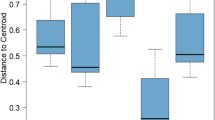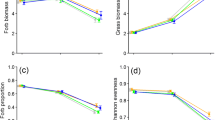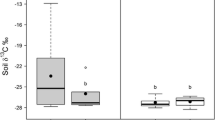Summary
Populations of bacterial-feeding nematodes and protozoa developing in soil amended with dried grass powder or a nutrient solution were monitored in experimental systems designed to prevent migration from surrounding unamended soil. The addition of nutrient solution stimulated both microbial activity, as determined by dehydrogenase activity, and protozoa, but brought about no increase in nematode numbers. Amendment of soil with grass, however, caused an increase in both types of grazer, with the maximum biomass of protozoa (180 μg g-1) exceeding that of bacterial-feeding nematodes (42 μ g-1). The decomposing grass was rapidly colonised by rhaditid nematodes, mainly Caenorhabditis sp. Incubating grass-amended soil in the absence of any surrounding soil, to prevent migration, changed the microflora from predominantly bacterial to predominantly fungal, and so could not be used to compare treatments with and without migration. Surrounding the amended soil with sterilised soil prevented migration and caused no detectable change in the microflora. This treatment demonstrated that migration plays an important part in the colonisation of decomposing substrates by nematodes, but that protozoa do not migrate in soil. The nematodes migrated from a volume of unamended soil that was equivalent to eight times the volume of amended soil. The potential effects of the large grazing pressure on the subsequent decomposition of the grass residue are discussed.
Similar content being viewed by others
References
Anderson RV, Coleman DC (1982) Nematode temperature responses: A niche dimension in populations of bacterial-feeding nematodes. J Nematol 14:69–76
Barsdate RJ, Prentki RT, Fenchel T (1974) Phosphorus cycle of model ecosystems: Significance of decomposer food chains and effect of bacterial grazers. Oikos 25:239–251
Bianchi M (1989) Unusual bloom of star-like prosthecate bacteria and filaments as a consequence of grazing pressure. Microb Ecol 17:137–142
Christensen S, Griffiths BS, Ekelund F, Rønn R (1992) Huge increase in bacterivores on freshly killed barley roots. FEMS Microbiol Ecol 86:303–310
Coleman DC, Anderson RV, Cole CV, Elliott ET, Woods L, Campion MK (1978) Trophic interactions in soils as they affect energy and nutrient dynamics: IV. Flows of metabolic and biomass carbon. Microb Ecol 4:373–380
Darbyshire JF (1972) Nitrogen fixation by Azotobacter chroococcum in the presence of Colpoda steini: 1. The influence of temperature. Soil Biol Biochem 4:359–369
Darbyshire JF, Wheatley RE, Greaves MP, Inkson RHE (1974) A rapid micro-method for estimating bacterial and protozoan populations in soil. Rev Ecol Biol Sol 11:465–475
Freckman DW (1988) Bacterivorous nematodes and organic-matter decomposition. Agric Ecosyst Environ 24:195–217
Grewal PS (1991) Influence of bacteria and temperature on the reproduction of Caenorhabditis elegans (Nematoda Rhabditidae) infesting mushrooms (Agaricus bisporus). Nematologica 37:72–82
Grewel PS, Wright DJ (1992) Migration of Caenorhabditis elegans (Nematoda Rhabditidae) larvae towards bacteria and the nature of the bacterial stimulus. Fundam Appl Nematol 15:159–166
Griffiths BS (1986) Mineralization of nitrogen and phosphorus by mixed cultures of the ciliate protozoan Colpoda steinii, the nematode Rhabditis sp. and the bacterium Pseudomonas fluorescens. Soil Biol Biochem 18:637–641
Griffiths BS (1989a) Improved extraction of iodonitrotetrazolium-formazan from soil with dimethylformamide. Soil Biol Biochem 21:179–180
Griffiths BS (1989b) Enhanced nitrification in the presence of bacteriophagous protozoa. Soil Biol Biochem 21:1045–1051
Griffiths BS (1990) A comparison of microbial-feeding nematodes and protozoa in the rhizosphere of different plants. Biol Fertil Soils 9:83–88
Griffiths BS, Ritz K (1988) A technique to extract, enumerate and measure protozoa from mineral soils. Soil Biol Biochem 20:163–173
Griffiths BS, Boag B, Neilson R, Palmer L (1990) The use of colloidal silica to extract nematodes from small samples of soil or sediment. Nematologica 36:465–473
Griffiths BS, Young IM, Boag B (1991) Nematodes associated with the rhizosphere of barley (Hordeum vulgare). Pedobiologia 35:265–272
Hewitt EJ (1966) Sand and water culture methods used in the study of plant nutrition, 2nd edn. Commonwealth Agricultural Bureaux, Tech Commun No. 22, East Malling, Kent
Kuikman PJ, Van Elsas JD, Jansen AG, Burgers SLGE, Van Veen JA (1990) Population dynamics and activity of bacteria and protozoa in relation to their spatial distribution in soil. Soil Biol Biochem 22:1063–1073
Laing R (1976) The soils of the country round Perth, Arbroath and Dundee. Memoirs of the Soil Survey of Great Britain, HMSO, Edinburgh
Pinkerton JN, Mojtahedi H, Santo GS, O'Bannon JH (1987) Vertical migration of Meloidogyne chitwoodi and M. hapla under controlled temperature. J Nematol 19:152–157
Pradhan GB, Senapati BK, Dash MC (1988) Relationship of soil nematode populations to carbon: nitrogen in tropical habitats and their role in decomposition of litter amendments. Rev Ecol Biol Sol 25:59–76
Robertson WM, Birch ANE, Fellows LE, Geoghegan IE (1992) Control of Meloidogyne javanica, M. incognita and Globodera rostochiensis by fructose, glucose, sucrose and mannose. Nematologica 38:432
Sinclair JL, Alexander RM (1989) Effect of protozoan predation on relative abundance of fast-and slow-growing bacteria. Can J Microbiol 35:578–582
Smith GS, Johnston CM, Comforth IS (1983) Comparison of nutrient solutions for the growth of plants in sand culture. New Phytol 94:537–548
Snedecor GW, Cochran WG (1980) Statistical methods. The Iowa State University Press, Ames, Iowa
Sohlenius B (1968) Studies of the interactions between Mesodiplogaster sp. and other rhabditid nematodes and a protozoan. Pedobiologia 8:340–344
Sohlenius B, Boström S (1984) Colonization, population development and metabolic activity of nematodes in buried barley straw. Pedobiologia 27:67–78
Southey JF (1970) Laboratory methods for work with plant and soil nematodes. Ministry of Agriculture, Fisheries and Food, Tech Bull 2, HMSO, London, pp 46–47
Stout JD, Heal OW (1967) Protozoa. In: Burgess A, Raw F (eds) Soil biology. Academic Press, London, pp 149–195
Sundin P, Valeur A, Olsson S, Odham G (1990) Interactions between bacteria-feeding nematodes and bacteria in the rape rhizosphere: Effects on root exudation and distribution of bacteria. FEMS Microbiol Ecol 73:13–22
Viglierchio DR (1990) Carbon dioxide sensing by Panagrellus silusiae and Ditylenchus dipsaci. Rev Nematol 13:425–432
Author information
Authors and Affiliations
Rights and permissions
About this article
Cite this article
Griffiths, B.S., Caul, S. Migration of bacterial-feeding nematodes, but not protozoa, to decomposing grass residues. Biol Fertil Soils 15, 201–207 (1993). https://doi.org/10.1007/BF00361612
Received:
Issue Date:
DOI: https://doi.org/10.1007/BF00361612




